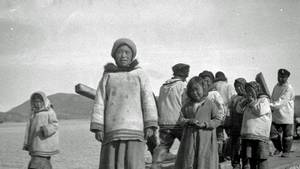“We have to overcome distrust and hostility, make things compatible, and become agreeable. For this to happen, from the Inuit perspective, many things need to be considered.” – Amagoalik, Jon. 2012

The Arctic is changing. The thawing of permafrost and icecaps induced by climate change has shaken Inuit livelihood and led to an international push for resource exploration and development. Canada’s claim to Arctic sovereignty, however, may not be as secure as Mr. Harper would like to think. Arctic sovereignty has yet to be officially declared and remains largely dependent on the effective occupation and the cooperation of the Inuit communities to self-identify as Canadians under rule of the Canadian government. Conversely, Arctic historian Shelagh Grant explains that Inuit communities generally consider themselves as part of the environment and distinct from Canadian society. This tension currently frames resource development in the Arctic and is the result of a legacy of colonial abuses and failed reconciliation efforts by the Canadian government.
A poignant event that framed the distrust of the Inuit people with the Canadian Government was the 1950s Inuit relocation experiment from Northern Quebec’s Ungava peninsula to Ellesmere and Cornwallis Islands in the Arctic Archipelago. Specifically, in 1953 and 1955 the Canadian government relocated eleven Inuit families from the Port Harris region and four families from Pond Inlet to new communities at Grise Fiord and Resolute Bay. Some Arctic historians claim that this relocation to the high Arctic was a forethought of the Canadian government to secure sovereignty to the Arctic via effective occupation of the Inuit during the Cold War. It also served as an attempt to disseminate and remove Inuit culture from modern society.
The relocation program occurred during a time when Inuit were still referred to as Eskimo, and the paternalistic Canadian Government perceived the project as a “humanitarian success.” During the first Eskimo Affairs conference in 1952 that would finalize the relocation program, the Government rationalized that they were acting for the good of the Inuit, despite not inviting any Inuit representatives:
The only reason why Eskimos were not invited to the meeting was, apart
from the difficulties of transportation and language, that it was felt that few, if any,
of them have yet reached the stage where they could take a responsible part in
such discussions.
The High Arctic exiled families suffered great hardship in the new landscape despite what the Canadian government had promised them. Hunting and shelter was scarce, winters were darker, and partnership options were limited because only a few youth were brought into the new community. Many Inuit needlessly perished during the beginning of the relocation experiment, though most survived through fierce adaptation. Among the survivors was Jon Amagoalik, a renowned Inuit responsible for leading the push for the self-governing Nunavut Land Claim Agreement.
Despite extensive oral histories, the Canadian government failed to accurately reflect Inuit colonial experiences in official government records of Canadian history. This denial of Inuit historical perspectives is perhaps best exemplified by the controversial reports that we published by the government on the Inuit High Arctic Exiles, popularly referred to as the “Hickling Report” of 1990. Published by the Hickling Corporation, the “Assessment of the factual basis of certain allegations made before the Standing Committee on Aboriginal Affairs concerning the relocation of Inukjuak Inuit families in the 1950s” concluded the following:
Our study reveals that the main reason for the decision by the Government to
encourage some Inuit families to relocate to the High Arctic at that time was a
concern to improve the living conditions of Inuit, particularly in the Hudson Bay
region. Relocation from those depressed areas was seen, by both government
officials and the Inuit themselves, as a way of breaking out of a growing pattern
of welfare dependency, and as a means of providing the Inuit with new and better
economic opportunities through improved hunting, trapping and wage
employment.
Government commissioned studies would continue to proliferate the theory that the relocation was a humanitarian project aimed to help the Inuit that was highly successful, and deny that they were forcibly relocated. Fortunately, the descendants of the relocated families pushed for further reevaluation and were unrelenting in their request for an official government apology (which they were repeated denied). This pressure on Canadian officials led to significant fiscal compensation throughout the 80s and 90s, as well as the passing of Nunavut Land Claim Agreement Act and the Nunavut Act by the Canadian Parliament which began in 1993 and was completed in 1999. Interestingly, this pressure did not result in an apology until 2010 when Minister of Indian Affairs and Northern Development, Jon Duncan, released a statement entitled “Apology for the Inuit High Arctic Relocation.”
The relocation program is just one example of the hardship that unjustly burdened the livelihood and strength of Inuit communities. It is important to note that the Inuit also survived through attempted genocides, cultural oppression, psychological and sexual abuse, and a general lack of recognition of basic human rights. Captured by Inuit vocal histories, these early interactions are pivotal to framing the contemporary Crown and Inuit relationship.
